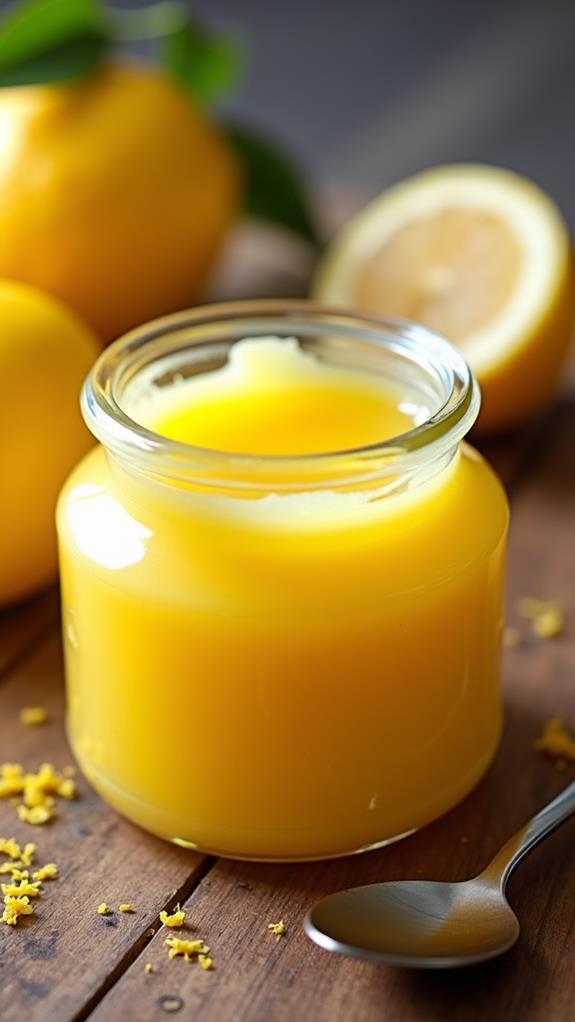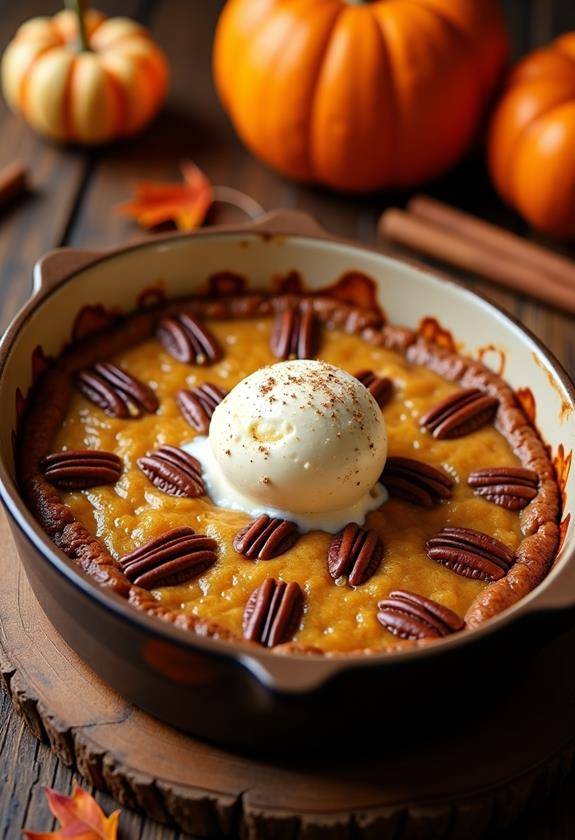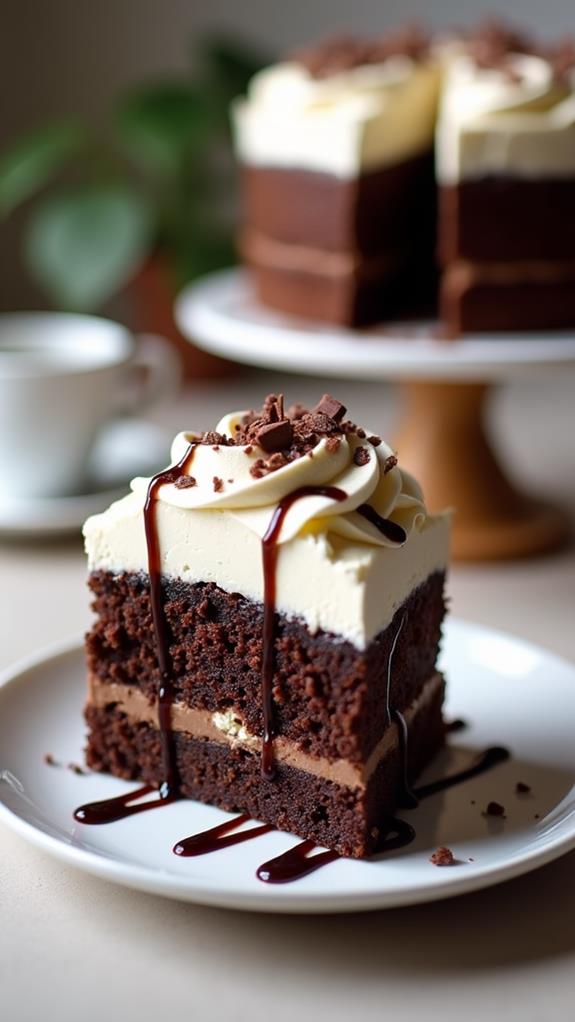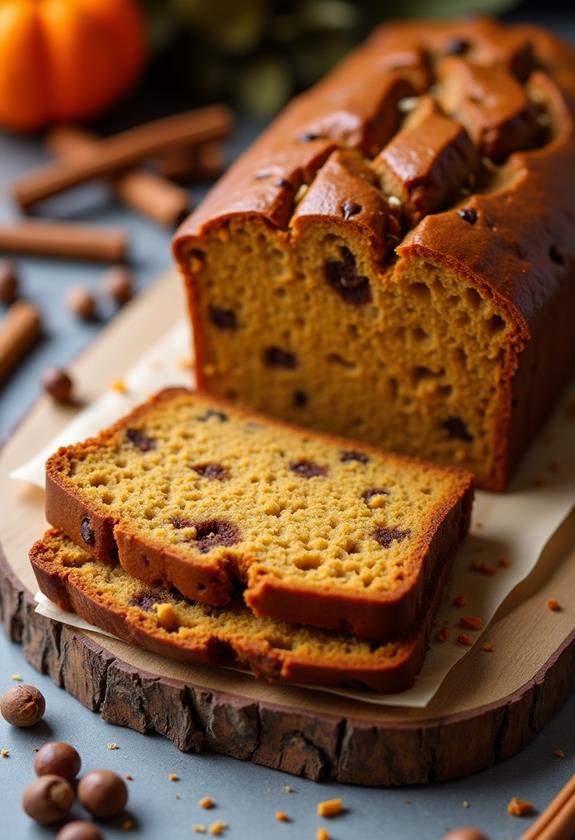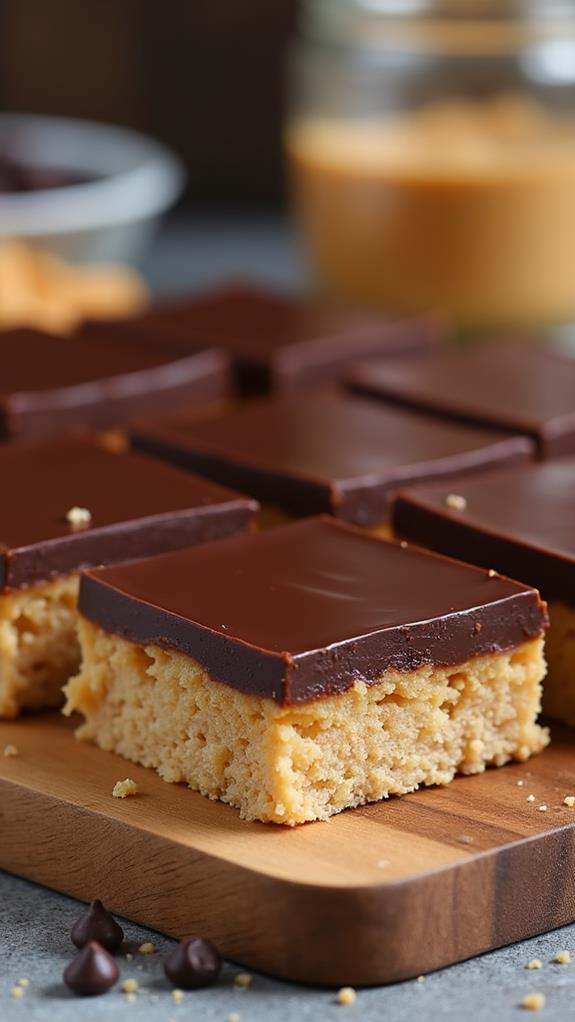French Macarons Recipe
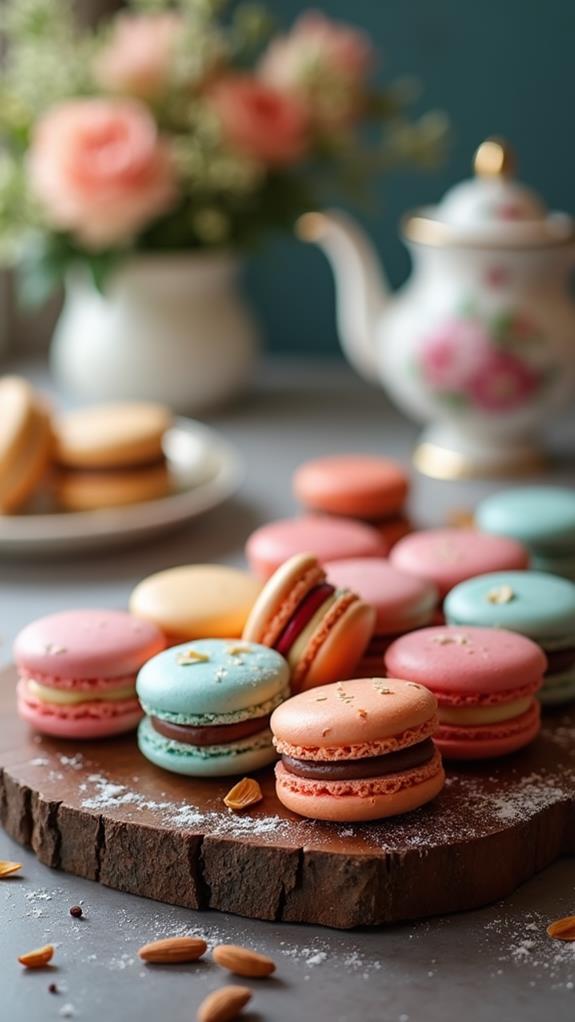
Crafting French macarons might seem challenging at first, but with the right approach, you'll find it manageable. You start by sifting almond flour and powdered sugar, ensuring a smooth texture. Whipping the egg whites to stiff peaks is key, as is the gentle folding of the dry ingredients into the meringue. Piping the batter into perfect circles requires precision, and the waiting time for them to form a skin is essential. Yet, there's a secret to mastering these steps that transforms your macarons into bakery-quality delights. Curious about what that might be? Let's explore further.
Recipe
French macarons are a sophisticated and elegant pastry that has captured the hearts of dessert lovers worldwide. Known for their delicate, crisp shells and soft, chewy interiors, these little confections are a delightful treat for any occasion. The classic macaron is made with almond flour and sandwiched together with a variety of fillings, such as buttercream, ganache, or jam. Though they can be challenging to perfect, the reward of biting into a homemade macaron makes the effort worthwhile.
The process of making macarons requires careful attention to detail and patience. It involves creating a meringue by whipping egg whites and sugar, then folding in almond flour to form a smooth batter. The mixture is piped into rounds and baked until the characteristic "feet" develop. With practice, you can achieve beautifully smooth shells and a perfect texture that will impress any guest. Whether you're crafting them for a special event or simply indulging yourself, macarons are sure to be a hit.
Ingredients:
- 1 cup almond flour
- 1 3/4 cups powdered sugar
- 3 large egg whites
- 1/4 cup granulated sugar
- 1/2 teaspoon vanilla extract
- Food coloring (optional)
- Filling of your choice (e.g., buttercream, ganache, jam)
To make French macarons, start by sifting the almond flour and powdered sugar together into a bowl, guaranteeing no lumps remain. In a separate, clean bowl, beat the egg whites until they form soft peaks. Gradually add granulated sugar, continuing to beat until stiff peaks form. Incorporate the vanilla extract and food coloring if desired.
Gently fold the almond flour mixture into the meringue, being careful not to deflate it, until the batter flows in thick ribbons. Pipe small circles onto a parchment-lined baking sheet, tap the sheets to release air bubbles, and let them sit at room temperature for 30 to 60 minutes until a skin forms. Bake at 300°F (150°C) for 15-18 minutes, then cool completely before filling.
For the best results, verify all your utensils are grease-free, as even a trace of oil can prevent the egg whites from whipping properly. Use aged egg whites, separated a day in advance and stored in the fridge, for a more stable meringue.
When folding the almond flour mixture into the meringue, do so gently to maintain its volume. Finally, let your assembled macarons sit in the fridge for 24 hours before serving to allow the flavors to meld and improve their texture. Enjoy the fruits of your labor with these exquisite homemade French macarons!
Cooking Steps
Alright, let's get started on the fun part—making those delicious macaron shells!
First, sift your almond flour and powdered sugar together, making sure they're as smooth as butter, no lumps allowed.
Next, whip those egg whites until they're as fluffy as a cloud, then gently fold in the dry ingredients; once that's done, you'll pipe the batter into cute little circles and let them chill out until they form a skin.
Step 1. Sift Dry Ingredients Together
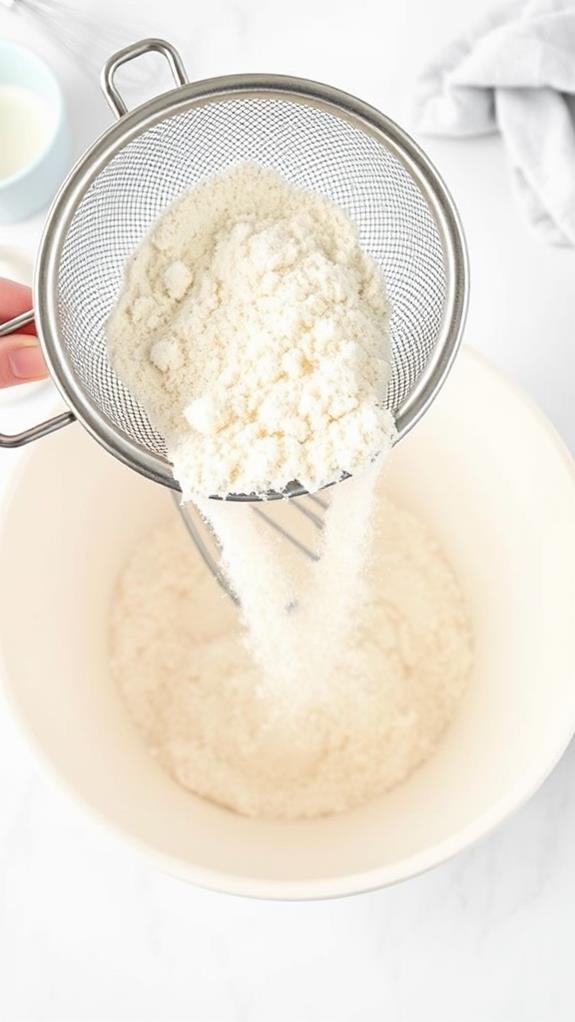
Sifting the dry ingredients is an essential step in achieving smooth and even macaron shells. Grab your almond flour and powdered sugar, and pour them into a fine-mesh sieve over a bowl.
Now, here's where you can pretend you're a snowstorm, shaking gently to let the fine particles fall through. This helps eliminate lumps and guarantees a consistent texture. If you spot stubborn clumps, don't be afraid to give them a little nudge with a spoon.
You'll notice a fluffy, uniform mixture that's perfect for creating those delicate shells. Remember, skipping this step could lead to unsightly bumps on your macarons, and nobody wants that!
Step 2. Whip Egg Whites to Peaks
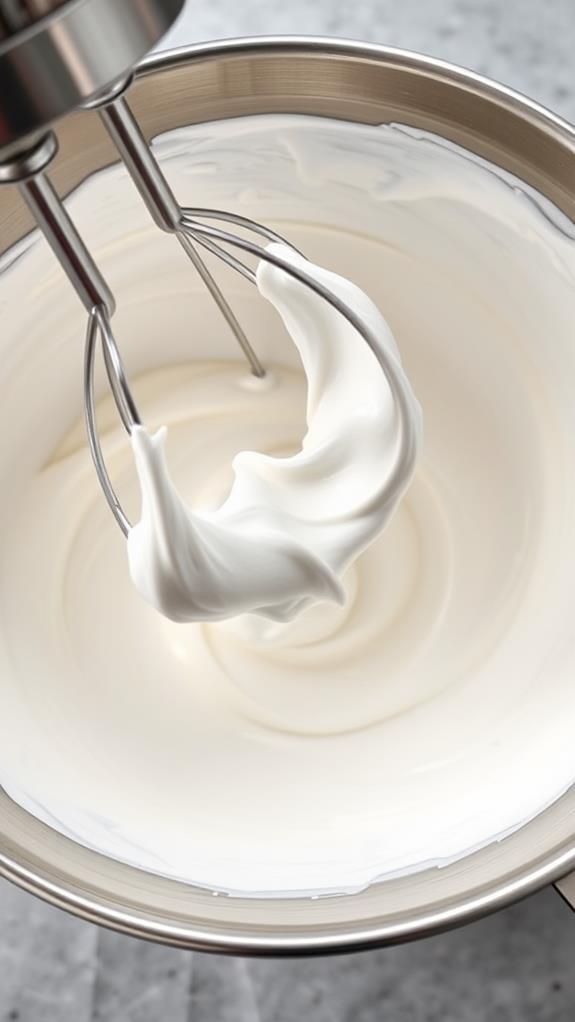
To achieve the perfect meringue for your macarons, start by ensuring your mixing bowl and whisk are completely clean and free of any grease.
Any leftover residue can sabotage your efforts, so give them a good wipe, like you've found the last piece of chocolate in the house.
Now, grab those egg whites and start whipping them on medium speed until foamy.
Slowly add granulated sugar, a little at a time, and increase the speed to high.
You'll want to whip until stiff peaks form, which means when you lift the whisk, the meringue should stand tall and proud without drooping.
It's like your egg whites have finally found their life purpose—standing firm and ready for the next delicious step!
Step 3. Fold Dry Mix Into Meringue
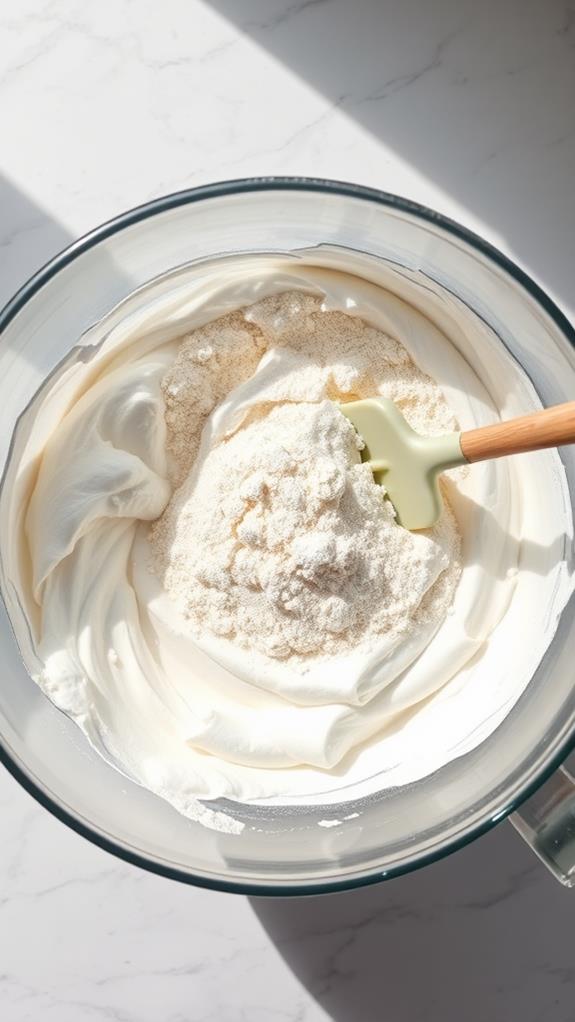
Folding the dry mix into your meringue is an essential step in making macarons.
Start by gently sprinkling a third of your almond flour and powdered sugar mixture over the meringue. Use a spatula to fold it in with care, turning the bowl as you go.
Don't rush—think of it as a zen exercise for bakers. Continue adding the dry mix in two more parts, folding until the batter flows like thick, luscious lava.
Be cautious not to overmix; you don't want to deflate those precious peaks. Remember, patience is key!
You'll know it's ready when it slowly ribbons off your spatula. Trust in your spatula, embrace the fold, and channel your inner macaron whisperer!
Step 4. Pipe Batter Into Circles
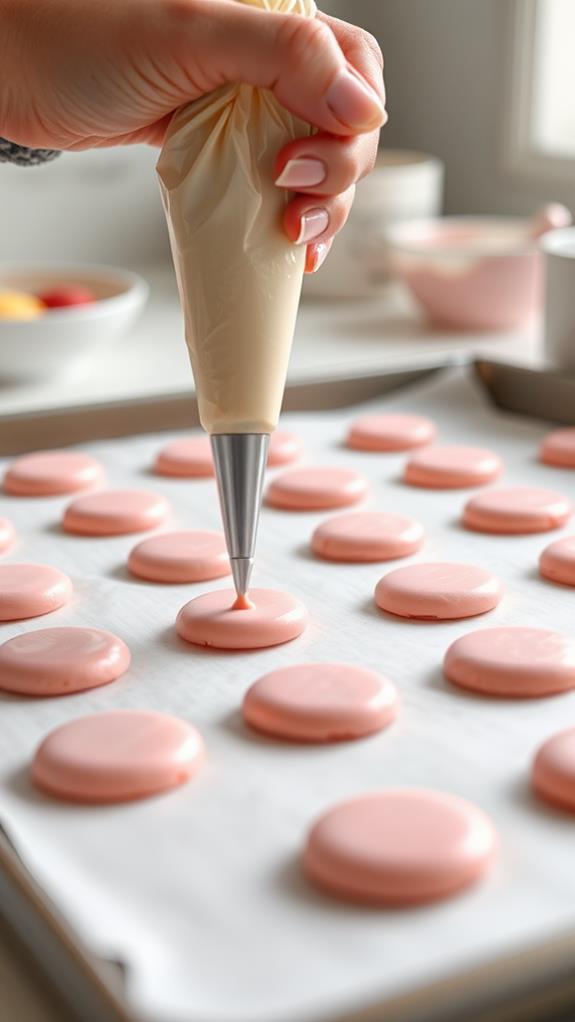
Once you've achieved that perfect lava-like consistency with your macaron batter, it's time to pipe it into neat circles.
Grab your piping bag fitted with a round tip, and fill it with the batter. Now, channel your inner artist and pipe small circles, about the size of a two-euro coin, onto a baking sheet lined with parchment paper.
Keep the tip close to the surface to control the batter's flow. Remember, consistency is key, so try to make each circle the same size.
Don't worry if they're not perfect; macarons have charm in their imperfections!
Give the tray a firm tap on the counter to release any air bubbles, and voilà! You've got your future macarons ready for the next step.
Step 5. Let Macarons Form Skin

After piping your batter into circles, let the macarons sit undisturbed at room temperature so they can form a skin.
This step is essential, as it helps the macarons develop their signature crispy shells and prevents cracking.
You'll know the skin is ready when you can lightly touch the surface without any batter sticking to your finger—no one wants sticky fingers!
This usually takes about 30 to 60 minutes, depending on humidity.
While waiting, resist the urge to poke or prod them; patience is key here.
This resting period allows the macaron feet to rise beautifully during baking.
Final Thoughts
Ultimately, making French macarons is a rewarding endeavor that combines precision and creativity.
Sure, they can be a bit finicky, but that's part of the fun! You'll find yourself whisking, folding, and piping with a newfound appreciation for these delicate treats.
Remember, practice makes perfect. Each batch will teach you something new, whether it's mastering the perfect meringue or getting those elusive "feet" just right.
Don't be discouraged by a few cracked shells; even the best bakers have their off days.
Enjoy experimenting with flavors and colors, turning your kitchen into a macaron wonderland.
And when you finally bite into that perfect macaron, you'll know all your efforts were worth it.
Share them with friends and family—they'll be impressed!
Frequently Asked Questions
Can I Use Different Types of Flour Instead of Almond Flour?
You can substitute almond flour with other nut flours, like pistachio or hazelnut, for unique flavors. However, switching to non-nut flours compromises texture and taste, potentially causing issues with the macaron's structure and consistency.
How Can I Prevent My Macarons From Cracking?
To prevent your macarons from cracking, make sure you let the piped batter rest until a skin forms. Tap the baking sheet to release air bubbles. Also, check your oven temperature and avoid overmixing the batter.
What Is the Best Way to Store Macarons?
Store your macarons in an airtight container to keep them fresh. Place them in the fridge for up to a week, but bring them to room temperature before serving for the best texture and flavor.
Can I Make Macarons Without Food Coloring?
You can definitely make macarons without food coloring. They'll still taste delicious and have the same texture. If you want natural hues, try adding ingredients like cocoa powder or matcha. Enjoy your homemade creations in their purest form!
How Do I Know if My Macarons Are Overbaked?
You'll know your macarons are overbaked if they have browned tops or become too hard and crunchy. They should have smooth, shiny shells with a soft, chewy interior. Check for these signs to guarantee ideal macarons.
Conclusion
You've made it to the end, and now you know the secret to making those fancy French macarons! Remember, practice makes perfect, so don't stress if your first batch isn't bakery-perfect. Enjoy the process, have fun with flavors, and embrace any imperfections—they're part of the charm! With a little patience and a lot of love, you'll soon be impressing friends and family with these delightful treats. So grab your whisk, and let your macaron adventure begin!

